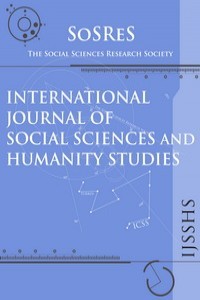DEVELOPMENT OF TEACHER COMPETENCES IN CREATING POWERFUL LEARNING ENVIRONMENTS IN VOCATIONAL SECONDARY EDUCATION
DEVELOPMENT OF TEACHER COMPETENCES IN CREATING POWERFUL LEARNING ENVIRONMENTS IN VOCATIONAL SECONDARY EDUCATION
secondary vocational education, powerful learning environments, development teacher competences,
___
- Anderson, H. (2009). Student succes : What keeps students in class? Paper presented at the Seventh International Conference of The Journal of Vocational Education and Training, Worcester
- College Oxford, 3rd-5th July. De Corte, E., Verschaffel, L., Entwistle, N., & van Merriënboer, J. J. G. (Eds.). (2003).
- Unravelling basic components and dimensions of powerful learning environments. Oxford: Elsevier Science. De Corte, E. (1990). Towards powerful learning environments for the acquisition of problemsolving skills. European Journal of Psychology of Education, 5(1), 5–19.
- De Corte, E. (2003). Designing learning environments that foster the productive use of acquired knowledge and skills. In E. De Corte, L. Verschaffel, N. Entwistle, & J. J. G. Van Merrienboer
- (Eds.), Powerful learning environments: Unravelling basic components and dimensions (pp. 21– ). Oxford: Elsevier Science. de Bruijn, E., Leeman, Y. & Overmaat, M. (2006), Authentiek en zelfgestuurd leren in het MBO.
- In Pedagogiek 26:11, 45-63, Assen : Van Gorcum. Green, B.(2009). Understanding and researching professional practice. Sense Publishers.
- Kicken, W., Brand-Gruwel, S., Van Merriënboer, J. J. G., & Slot, W. (2009). Design and evaluation of a development portfolio: How to improve students’ self-directed learning skills.
- Instructional Science. DOI 10.1007/s11251-008-9058-5.
- Könings, K.D., Brand-Gruwel, S. & Van Merriënboer, J.J.G. (2005). Towards more powerful learning environments through combining the perspectives of designers, teachers and students.
- British Journal of Educational Psychology, 75 (4), 645-660. Könings, K.D., Brand-Gruwel, S. & van Merriënboer, J.J.G. (2007). Teachers Perspective on
- Innovations: Implications for Educational Design. Teaching and Teacher Education. Levett-Jones, T.L. (2005). Self-directed learning: Implications and limitations for undergraduate nursing education, Nurse Education Today, 25, no. 1: 363-368.
- Meijers, F. & Kuijpers, M. (2007). De creatie van een krachtige loopbaangerichte leeromgeving: monoloog, dialoog of trialoog? Handboek Effectief Opleiden, 44 , 129-141.
- Merrill, M.D. (2002). First principles of instruction. Educational Technology Research and Development, 50, 43-59.
- Merrill, M.D. (2009). Findings e3 (effective, efficient and engaging) Instruction. Educational Technology, 49(3), 15-26.
- Van Merriënboer, J. J. G., & Paas, F. (2003). Powerful learning and the many faces of instructional design: Toward a framework for the design of powerful learning environments. In E. de Corte, L.Verschaffel, N. Entwistle, & J. J. G. van Merriënboer (Eds.), Unravelling basic components and dimensions of powerful learning environments (pp. 3-20). Oxford: Elsevier Science
- Başlangıç: 2009
- Yayıncı: Sosyal Bilimler Araştırmaları Derneği
RECRUITING OLDER VOLUNTEERS: FINDINGS FROM THE BELGIAN AGEING STUDIES
Sarah DURY, Dominique VERTÉ, Tine BUFFEL, Liesbeth De DONDER, Nico De WİTTE
CARE SHORTAGES IN LATER LIFE: THE ROLE OF INDIVIDUAL AND CONTEXTUAL VARIABLES IN FLANDERS, BELGIUM
Nico De WİTTE, Tine BUFFEL, Liesbeth De DONDER, Sarah Dury, Dominique Verté
Stefaan De Smet, Stijn Vandevelde, Dominique Verté, Eric Broekaert
VULNERABILITY OF AGRICULTURE TO CLIMATE CHANGE IN THE NEW MEMBER STATES OF EUROPEAN UNION
HOW DO JAPANESE SCHOOLS PROMOTE PARENTAL INVOLVEMENT?
İnge PLACKLÉ, Arno LİBOTTON, Nadine ENGELS, Gwendolyn HOTTON
COMPLEXITY AND INTEGRATED CHILDREN’S SERVICES IN THE UK
E-LEARNING EDUCATION SYSTEM IN UNIVERSITIES WITH INSTRUCTORS’ PERSPECTIVES AND A SURVEY IN TURKEY
Fazli YILDIRIM, Oktay KORUCU, Ceyhan AKTAS, Gokce KULE
OLDER PEOPLE AND SPORT, LOOKING BEYOND THE HEALTH PERSPECTIVE
Eva VONCK, Dominique VERTÉ, Liesbeth De DONDER, Tine BUFFEL, Nico De WİTTE, Sarah DURY
